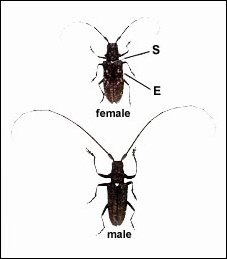 |
 | |
| Asian Longhorned Beetle
Anoplophora glabripennis (Motschulsky) |
Whitespotted Sawyer
Monochamus scutellatus (Say) | |
Origin and North American Range: Native to Asia; immigrant in North America (Brooklyn and Amityville, NY); interceptions of this species have occurred at ports of entry in North America. Hosts: Adults are drawn to recently felled, stressed, or apparently healthy hardwood trees. Overall appearance: Glossy black; very smooth and finely punctate (having microscopic dimples); 20-35 mm long. Elytra (E): Both sexes have up to 20 irregularly distinct white spots. Scutellum (S): Generally black. Antennae: Segments 3-11 distinctly banded white and black in both sexes; Female- antennae usually 1.3 times body length; Male- antennae usually 2.5 times the body length Legs: In both sexes, bluish-white especially on the dorsal surface |
Origin and North American Range: Native to North America; transcontinental from Alaska throughout Canada (and the Northern United States) and southward to North Carolina in the east and New Mexico in the west. Hosts: Adults are drawn to dying, stressed, or recently felled conifers. Overall appearance: Generally bronzy-black; coarsely and roughly punctate; 15-28 mm long. Elytra (E): Female- generally mottled with whitish patches; Male- generally completely bronzy-black. Scutellum (S): Generally white (covered with white or ashy-colored scales). Antennae: Female- faintly banded gray and black; slightly longer than the body; Male- all black; much longer than the body. Legs: In both sexes, generally dark or slightly grayish-black overall |
